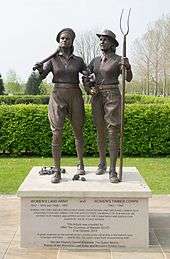Women's Timber Corps
The Women's Timber Corps (WTC) was a British civilian organisation created during the Second World War to work in forestry replacing men who had left to join the armed forces. Women who joined the WTC were commonly known as Lumber Jills.[1]

Formation
Formed in 1942, the origins of the WTC go back to the First World War when the Women's Timber Service had been formed to help with the war effort. In 1940 to solve a labour shortage and an increased demand for timber the Forestry Commission started recruiting women both as forestry workers but also to work in sawmills.[2] In 1942 responsibility passed from the Forestry Commission to the Home Timber Production Department of the Ministry of Supply and the women became part of the new corps.[2]
Organisation
As many of the women who had joined the Forestry Commission came from the Women's Land Army (WLA), the WLA took over the administration and recruitment for the WTC and although the WTC was officially part of the WLA it retained a separate identity.[3] The uniforms were identical except that the WTC replaced the WLA felt hat for a beret and wore the WTC badge.[1] A full set of kit consisted of:-
- 2 green jerseys
- 2 pairs of riding breeches
- 2 overall coats
- 2 pairs of dungarees
- 6 pairs of woolen knee socks
- 3 beige knit shirts
- 1 pair boots
- 1 pair of brown shoes
- 1 pair of gumboots or boots with leggings
- 1 green beret
- 1 melton overcoat
- 1 oilskin or mackintosh
- 2 towels
- a green armlet and a metal badge
- a bakelite hat badge[4]
The corps was divided into nine geographic areas responsible for the work and welfare of the women in that area.[5] Accommodation ranged from purpose built hutted camps, through small hotels and hostels to private billets.[5] Never as large as the WLA, the WLC did have a maximum strength of over 6,000 working throughout the United Kingdom.[2] The corps was a mobile organisation so the workers could be posted anywhere.
Duties
The work of the WTC included all the jobs involved with forestry including felling, snedding, loading, crosscutting, driving tractors, trucks, working with horses and operating sawmills. A more specialist skill was measuring which was the job of assessing the amount of timber in a tree, measuring the amount of timber felled, surveying new woodlands and identifying trees for felling.[5]
Initial training consisted of a four to six week course at one of the Corps depots[4] before being posted to a billet elsewhere. The work was heavy and arduous[5] but there was a grudging acceptance from farmers and foresters that the women of the WTC were as good as the men they had replaced.[1] Pay ranged from 35 to 46 shillings per week.[6] Towards the end of the war some of the women were considered skilled enough to be posted to Germany to help salvage the sawmills there.[4]
Disbandment and subsequent recognition
The WTC was disbanded in 1946 when each member was awarded a personal letter signed by Queen Elizabeth. Other than this no recognition of the WTC (or the WLA) was made and it was not until 2000 that former members of the WTC were allowed to take part in the annual Remembrance Sunday parade in London.[7] In 2007, the Department for Environment, Food and Rural Affairs announced that all surviving members of the WTC would be entitled to wear a new badge to commemorate their service in the Corps.[8]
In 2012, the Forestry Commission marked the 70th anniversary of the WTC.[9] On Remembrance Day 2012, BBC Countryfile broadcast a tribute to the work of the WTC with veteran members, filmed in the Forest of Dean.[10]
National memorial

On 10 October 2007 Forestry Commission Scotland unveiled a national memorial to the women of the WTC in the form of a life size bronze sculpture by Malcolm Robertson. The statue is in the Queen Elizabeth Forest Park near Aberfoyle, Stirling.[3]
In October 2014, a memorial statue to both the Women's Land Army and the Women's Timber Corps was formally unveiled at the National Memorial Arboretum in Alrewas, Staffordshire.[11]
Notes
- Brayley & McGregor p. 51.
- Swanston p. 1.
- "Women's Timber Corps Memorial". Forestry Commission. 2007. Retrieved 23 April 2010.
- Elder
- Swanston p. 3.
- Hendrie p. 41.
- "Women, War and Remembrance" (doc). Women’s History Network. 2010. p. 4. Retrieved 23 April 2010.
- "The Royal British Legion - Recent awards and badges". Royal British Legion. 2008. Retrieved 23 April 2010.
- "Calling all lumberjills". Forestry Commission.
- "Ellie And The Lumberjills". BBC Countryfile.
- "Memorial Arboretum Land Girls monument unveiled after three-year fundraising campaign". BBC News. BBC. 21 October 2014. Retrieved 8 November 2015.
References
- Brayley, Martin J & McGregor, Malcolm (2005). The British Home Front 1939–1945. Osprey Publishing. ISBN 1-84176-661-5.
- Elder, Rosalind (2009). "The Women's Timber Corps". womenstimbercorps.com. Retrieved 23 April 2010.
- Hendrie, James (2009). "Lumberjills" (pdf). Forestry Journal (12/09): 40–41. Retrieved 23 April 2010.
- Swanston, Catherine (1946). "The Health of Forestry Workers: A Survey of the Women's Timber Corps of Great Britain". Occupational and Environmental Medicine. BMJ. 3 (1): 1–10. doi:10.1136/oem.3.1.1. PMC 1035717. PMID 20983522. Retrieved 23 April 2010.
Further reading
- Meet the Members: A record of the Timber Corps of the Women's Land Army. Bristol: Bennett Brothers Ltd. 1945.
| Wikimedia Commons has media related to Women's Timber Corps. |